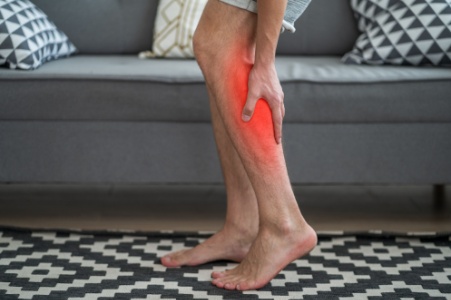Items filtered by date: September 2025
Symptoms and Causes of Degenerative Disc Disease

Degenerative disc disease occurs when the discs that cushion the vertebrae begin to wear down, reducing their ability to absorb shock and support normal spinal movement. These changes often develop with age, and can lead to pain that spreads from the back to the legs or feet. Tingling, weakness, and numbness may also occur when nerves are compressed. Although called a disease, it is actually a natural process of disc breakdown over time. Risk factors for degenerative disc disease include repetitive stress on the spine, sudden injury, obesity, and smoking, all of which can speed up disc deterioration. The discomfort may worsen during sitting, bending, or lifting, and can sometimes lead to instability or muscle spasms. A chiropractor can provide an evaluation, spinal adjustments, and supportive therapies to reduce pressure on the affected areas, improve alignment, and restore mobility. If you are experiencing spinal pain, it is suggested that you schedule an appointment with a chiropractor for an exam and natural treatment.
Degenerative Disc Disease
Degenerative disc disease, or DDD, is a condition characterized by the gradual wear and tear of the spinal discs, which act as cushions between vertebrae. As these discs deteriorate, they lose height, elasticity, and hydration, resulting in reduced shock absorption and increased friction between bones. This degeneration can lead to chronic pain, stiffness, and decreased mobility, often radiating to other areas of the body due to nerve irritation.
Management of Degenerative Disc Disease
Chiropractors manage degenerative disc disease by reducing stress on the spine and enhancing mobility to alleviate discomfort. They use targeted spinal adjustments to help improve alignment, which minimizes nerve compression and promotes better disc health. By restoring spinal balance, chiropractic care can help reduce pain and prevent further degeneration.
Complementary treatments like stretching exercises, strengthening routines, and postural training often accompany chiropractic adjustments to provide a comprehensive approach to managing DDD. These additional therapies aim to enhance flexibility, reinforce supporting muscles, and protect the spine from further strain.
Chiropractic care focuses on a non-invasive, holistic approach, offering relief without reliance on medication or surgery. By addressing the underlying mechanics of the spine, chiropractors work to help patients manage DDD symptoms effectively and enjoy improved quality of life over time.
1. How often should someone with degenerative disc disease see a chiropractor?
The frequency of visits varies based on individual needs, but patients often benefit from regular treatments initially, which can then be adjusted as symptoms improve or stabilize.
2. Will chiropractic care stop the progression of degenerative disc disease?
While chiropractic care cannot reverse the condition, it can help alleviate symptoms, reduce pain, and improve quality of life, making it easier to stay active, which may slow progression over time.
3. How does a chiropractor evaluate the progression of degenerative disc disease over time, and can they adjust their techniques as the condition evolves?
Chiropractors typically monitor changes in mobility, pain levels, and overall function, adjusting their treatment plans to accommodate increased sensitivity or stiffness as the disease progresses.
4. Does chiropractic care provide long-term relief for degenerative disc disease?
While chiropractic care may not cure degenerative disc disease, regular treatment can offer long-term relief by managing pain, reducing inflammation, and improving joint mobility, which can enhance quality of life over time.
If you have any questions please feel free to contact our office located in Leicester, MA .
Risk Factors for Pinched Nerves

A pinched nerve, also known as radiculopathy, occurs when irritation or compression affects a nerve root in the spine. This can happen in different regions, including cervical in the neck, thoracic in the mid back, lumbar in the lower back, and lumbosacral near the pelvis. Risk factors include poor posture, repetitive movements, arthritis, and disc herniation. Symptoms may involve sharp pain, tingling, numbness, or weakness radiating into the arms or legs, depending on the affected area. Chiropractors can help by restoring spinal alignment, reducing nerve pressure, and improving mobility. If you have developed a pinched nerve, it is suggested that you promptly consult a chiropractor who can offer effective, natural relief and treatment solutions.
Pinched Nerve
A pinched nerve occurs when surrounding tissues, such as bones, muscles, or tendons, apply excessive pressure on a nerve. This condition can cause pain, numbness, tingling, or weakness, often in the neck, back, or limbs. Everyday activities, poor posture, or repetitive motions are common triggers. Left untreated, the condition may worsen, leading to chronic discomfort and reduced mobility.
Chiropractors use a hands-on approach to relieve the pressure that causes a pinched nerve. By performing gentle spinal adjustments, they create space for the nerve to function properly, alleviating discomfort. Chiropractic care may also include stretching exercises to improve flexibility and targeted muscle work to reduce surrounding tension. Patients often receive guidance on posture and activity modifications to prevent recurrence. This tailored approach focuses on restoring normal nerve function and improving overall quality of life.
1. Are pinched nerves only caused by spinal issues?
No, they can also result from tight muscles, inflammation, or repetitive strain. Chiropractors address both spinal and muscular causes.
2. How does a chiropractor determine the location of a pinched nerve?
Chiropractors use physical exams, mobility tests, and sometimes imaging studies like X-rays to pinpoint the source of nerve compression.
For additional information, please contact our office located in Leicester, MA .
Chronic Headache Relief Through Alignment

If you suffer from chronic headaches, they may be linked to tension, nerve pressure, or strain in the neck and upper back. These factors can affect nearby nerves and contribute to ongoing headache pain. Gentle adjustments may help ease tension, improve alignment, and support better nerve function.
Find lasting relief from headache pain. Schedule your appointment today.
Causes and Symptoms of Muscle Spasms

A muscle spasm is an involuntary contraction that can occur suddenly and cause significant discomfort. Back and leg spasms are common and may be linked to overuse injuries, poor posture, or nerve compression. Dehydration and imbalances in minerals like potassium, calcium, and magnesium may increase the risk. Symptoms include sharp pain, stiffness, and difficulty moving the affected area. Muscle spasms may worsen with activity and sometimes involve muscle twitching. A chiropractor can evaluate posture, spinal alignment, and nerve function to determine possible causes. At an office visit, a chiropractor may use spinal adjustments, guided stretching, and other supportive methods to reduce pressure on nerves and restore movement. Identifying the source of spasms is important to prevent recurrence and improve mobility. If you are suffering from muscle spasms, it is suggested that you schedule an appointment with a chiropractor for natural relief solutions.
Muscle Spasms
Muscle spasms, or involuntary muscle contractions, can cause sudden pain and tightness, often disrupting daily activities and causing significant discomfort. Spasms are typically triggered by muscle strain, dehydration, poor circulation, or nerve irritation and can occur in any muscle, although they are most common in the neck, back, and legs.
Chiropractic care for muscle spasms aims to relieve muscle tension, improve circulation, and restore the body’s natural balance. By performing gentle adjustments to the spine or other affected areas, chiropractors work to realign the body and reduce nerve interference that may be contributing to the spasms. This approach can help relieve the pressure on muscles, encouraging them to relax and reducing the frequency and intensity of future spasms.
In addition to adjustments, chiropractic care may include stretching exercises, massage, and lifestyle recommendations to prevent recurrence. These exercises are designed to strengthen and support the muscles, improving flexibility and reducing muscle strain.
Chiropractic care offers a holistic, drug-free approach to managing muscle spasms, emphasizing long-term relief and muscle health. By addressing both the immediate symptoms and underlying causes, chiropractic treatment helps people find lasting relief, promoting muscle relaxation and supporting overall well-being.
Will the treatment cause additional pain or discomfort?
Patients sometimes worry that chiropractic adjustments or muscle manipulation will aggravate their spasms. Chiropractors emphasize that treatments are generally gentle and designed to alleviate discomfort without causing additional pain.
Will I feel immediate relief after each adjustment, or does it build over time?
While some patients feel immediate relief after a session, long-term improvement usually develops gradually with consistent treatment. Muscle tension and spasms often respond best to cumulative care over several sessions.
If you have any questions please feel free to contact our office located in Leicester, MA .
Chiropractic Solutions for Numbness and Tingling

Numbness and tingling are sensations that occur when nerves are irritated, compressed, or not functioning properly. These feelings may affect the hands, feet, arms, or legs, and are often described as pins and needles. Common causes include poor posture, nerve compression, spinal misalignment, diabetes, or injuries. Symptoms may involve weakness, burning sensations, or a loss of coordination. Risk factors include prolonged sitting, repetitive motions, aging, and underlying medical conditions. A chiropractor can help by correcting spinal alignment, improving nerve function, and relieving pressure that contributes to these uncomfortable sensations. If numbness or tingling is affecting your daily life, it is suggested that you consult a chiropractor who can provide natural and effective care for this bothersome condition.
Numbness and Tingling
Numbness and tingling sensations can disrupt daily life, often arising from issues like nerve compression, poor circulation, or structural imbalances. These symptoms, commonly felt in the hands, feet, arms, or legs, range from mild pins and needles to persistent discomfort. Conditions such as herniated discs, carpal tunnel syndrome, or peripheral neuropathy are frequent causes, often linked to irritated or restricted nerve pathways. Left untreated, these sensations may worsen, leading to reduced mobility or further nerve damage.
Chiropractic care addresses numbness and tingling by focusing on the root causes. A chiropractor evaluates spinal alignment, nerve function, and contributing factors like posture or muscle tension. Through targeted adjustments and therapies, they relieve nerve compression, improve circulation, and restore function. Lifestyle recommendations complement treatment, offering long-term relief and promoting nerve health.
1. Are numbness and tingling always nerve-related?
Not always. While often linked to nerve compression, these sensations can also result from poor circulation or systemic conditions. Chiropractors assess for nerve involvement and recommend appropriate care or referrals.
2. Can numbness and tingling affect only one side of the body?
Yes, these symptoms can be unilateral, often indicating localized nerve compression or structural imbalances, which chiropractors can identify and treat.
For additional information, please contact our office located in Leicester, MA .
Getting Relief From Shoulder Pain

Shoulder pain can arise from a variety of causes, such as repetitive activities, arthritis, fractures, and conditions like bursitis or frozen shoulder syndrome. It may also stem from muscle strains, rotator cuff tears, or poor posture. Chiropractors offer various treatment options to help alleviate shoulder pain. These can include spinal adjustments to relieve pressure on the nerves that may be contributing to pain, and soft tissue therapy to reduce inflammation and muscle tightness. Specific exercises to improve mobility and strengthen the muscles around the shoulder may be recommended. Chiropractors can also provide ergonomic advice to correct posture and avoid further strain on the shoulder. If you are experiencing shoulder pain, it is suggested that you schedule an appointment with a chiropractor for appropriate treatment options.
Shoulder and arm pain can significantly affect daily life, making simple tasks challenging. This pain often arises from issues such as rotator cuff injuries, tendonitis, nerve compression, or even misalignments in the spine or shoulders. Symptoms can range from a dull ache and stiffness to sharp, shooting pain that radiates down the arm, limiting mobility and impacting overall comfort.
Chiropractic care offers a non-invasive approach to managing shoulder and arm pain by focusing on the musculoskeletal system. Chiropractors assess the shoulder, neck, and spine alignment to identify potential sources of nerve compression or joint dysfunction. Gentle adjustments aim to restore proper alignment in the affected areas, which can relieve nerve pressure, reduce inflammation, and encourage natural healing.
In addition to adjustments, chiropractors may recommend exercises to strengthen the surrounding muscles and improve flexibility. Stretching routines can help relieve tension, while strengthening exercises provide better support to the shoulder and arm, preventing further strain.
By addressing the root causes of discomfort, chiropractic care provides a holistic approach to managing shoulder and arm pain. This method promotes long-term relief by restoring alignment, enhancing function, and encouraging a more active, pain-free lifestyle without relying on medication or surgery.
1. How does chiropractic care help with frozen shoulder?
Chiropractors use gentle mobilization and targeted adjustments to improve joint flexibility. Soft tissue therapies can also reduce inflammation and improve function.
2. Is shoulder pain always caused by a shoulder issue?
No, shoulder pain can originate from the neck or upper back due to nerve compression or referred pain. Chiropractors assess the entire musculoskeletal system to find the root cause.
3. Are chiropractic adjustments safe for shoulder pain caused by arthritis?
Yes, chiropractors use gentle, non-invasive techniques tailored to reduce arthritis-related pain and improve joint mobility.
If you have any questions please feel free to contact our office located in Leicester, MA .

